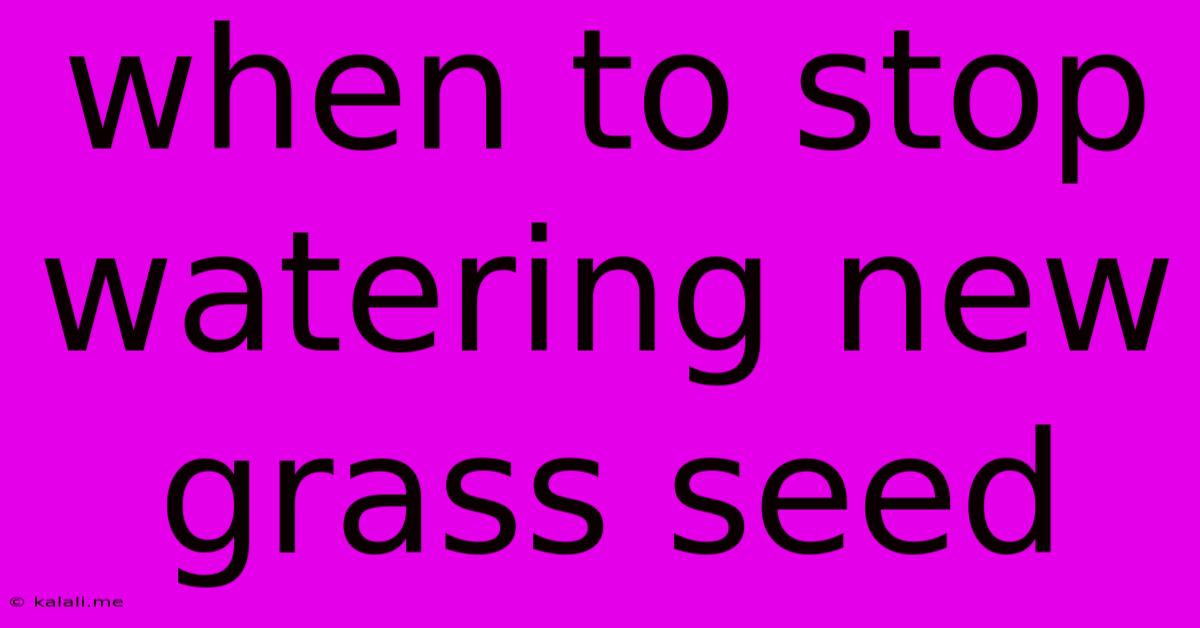When To Stop Watering New Grass Seed
Kalali
May 25, 2025 · 3 min read

Table of Contents
When to Stop Watering New Grass Seed: A Guide to Achieving a Lush Lawn
Knowing when to stop watering new grass seed is crucial for establishing a healthy, thriving lawn. Overwatering can lead to fungal diseases and root rot, while underwatering will hinder germination and growth. This guide provides a comprehensive understanding of the watering process, helping you achieve that perfect, lush green lawn.
The critical period of watering is during germination and establishment. Once your grass seed has sprouted and developed a strong root system, your watering needs will change significantly. This article will explain how to determine that crucial point and transition to a more sustainable watering schedule.
Understanding the Germination Stage
The first few weeks after seeding are the most critical. The seeds need consistent moisture to germinate and develop their initial root system. The soil should remain consistently moist, but not soggy. Think of it like a damp sponge – you should be able to squeeze a small amount of water out, but it shouldn't be dripping wet.
- Frequency: Water several times a day, especially during hot, dry weather. Shorter, more frequent watering sessions are better than one long, deep watering. This encourages shallower root growth, which is better for drought tolerance in the long run.
- Depth: Aim for light watering that just moistens the top inch of soil. Deep watering at this stage can wash away seeds or cause them to rot.
- Signs of adequate moisture: The soil surface will look dark and moist, and the seed will begin to sprout within a week or two, depending on the type of grass seed and environmental conditions.
Transitioning to Less Frequent Watering
As the grass seedlings develop their first true leaves (the leaves after the initial seed leaves), you can gradually reduce the watering frequency. The key indicator is the establishment of a strong root system. This generally occurs when the grass reaches a height of 2-3 inches.
- Observe the grass: If the grass blades start to look slightly wilted in the morning, it indicates that it's time to water. However, if the wilting persists throughout the day, you may need to adjust your watering schedule.
- Check soil moisture: Dig a few inches into the soil. If the soil feels dry, it's time to water.
- Reduce frequency: Slowly reduce watering frequency to every other day, then to every two days, and eventually, to a deep watering once a week or as needed based on weather conditions.
Maintaining Your Lawn After Establishment
Once your grass is fully established (typically after 6-8 weeks), your watering needs will further reduce. Deep, infrequent watering will encourage deep root growth, making your lawn more drought-tolerant. This encourages a stronger, healthier root system, making the lawn more resilient to environmental stresses.
- Deep watering: Water deeply and less frequently to encourage deeper root growth. Aim for 1-1.5 inches of water per watering session.
- Monitor for stress: Keep an eye on your lawn for signs of drought stress like browning or wilting. Adjust your watering schedule accordingly.
- Consider your climate: In hot, dry climates, you'll need to water more frequently than in cooler, more humid climates.
Understanding Your Grass Type
Different types of grass have different watering requirements. Research the specific needs of your grass species for optimal results. Some grasses are more drought-tolerant than others, requiring less frequent watering once established.
By following these guidelines and carefully monitoring your lawn, you can achieve a lush, healthy lawn while conserving water and ensuring the long-term health of your grass. Remember, consistency and observation are key to success in establishing and maintaining a beautiful lawn.
Latest Posts
Latest Posts
-
What Does Low Oil Pressure Mean
May 25, 2025
-
Can You Check Out Of A Hotel Early
May 25, 2025
-
Bash If File Does Not Exist
May 25, 2025
-
Why Does My Car Ac Smell
May 25, 2025
-
How To Say And In German
May 25, 2025
Related Post
Thank you for visiting our website which covers about When To Stop Watering New Grass Seed . We hope the information provided has been useful to you. Feel free to contact us if you have any questions or need further assistance. See you next time and don't miss to bookmark.